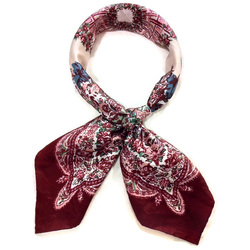One of our new scarves, Summer in Central Park, is made of 100% acetate.
Never heard of acetate before? Here is a great and explaining article:
Acetate is derived from cellulose by reacting purified cellulose from wood pulp with acetic acid and acetic anhydride in the presence of sulfuric acid. It is then put through a controlled, partial hydrolysis to remove the sulfate and a sufficient number of acetate groups to give the product the desired properties. The anhydroglucose unit, is the fundamental repeating structure of cellulose, has three hydroxyl groups which can react to form acetate esters. The most common form of cellulose acetate fiber has an acetate group on approximately two of every three hydroxyls. This cellulose diacetate is known as secondary acetate, or simply as “acetate”.
AcetateFiber Characteristics
Note: Acetate is adversely affected by acetone and other organic solvents, such as nail polish remover and perfumes containing these solvents.
by fibersource.com
Acetate is derived from cellulose by reacting purified cellulose from wood pulp with acetic acid and acetic anhydride in the presence of sulfuric acid. It is then put through a controlled, partial hydrolysis to remove the sulfate and a sufficient number of acetate groups to give the product the desired properties. The anhydroglucose unit, is the fundamental repeating structure of cellulose, has three hydroxyl groups which can react to form acetate esters. The most common form of cellulose acetate fiber has an acetate group on approximately two of every three hydroxyls. This cellulose diacetate is known as secondary acetate, or simply as “acetate”.
AcetateFiber Characteristics
- Luxurious feel and appearance
- Wide range of colors and lusters
- Excellent drapability and softness
- Relatively fast drying
- Shrink, moth and mildew resistant
- Handwash in warm water with mild suds.
- Do not twist or wring out garment.
- Do not soak colored items.
- Press while damp on wrong side with cool iron. For finishing on the right side, use a pressing cloth.
Note: Acetate is adversely affected by acetone and other organic solvents, such as nail polish remover and perfumes containing these solvents.
by fibersource.com

 RSS Feed
RSS Feed